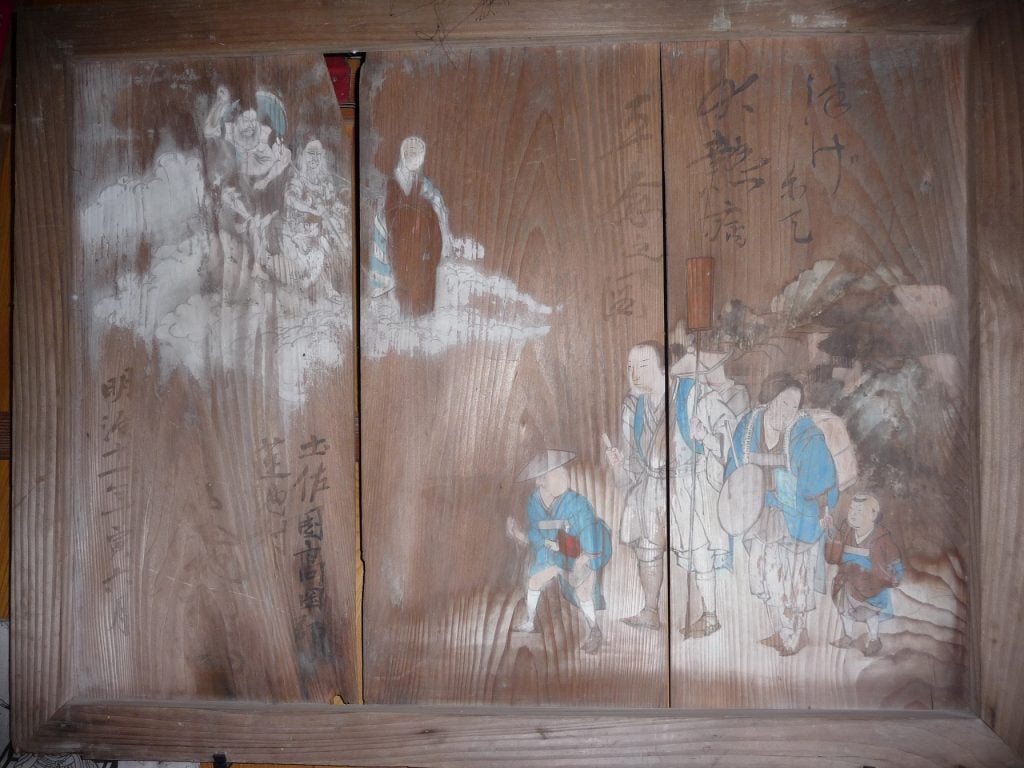Oliver Statler (1912-2003), a renowned scholar on the Shikoku pilgrimage and author of Japanese Pilgrimage (1983), said in a documentary that “visits to the temples do not constitute the pilgrimage, they merely punctuate it.” He was referring to the eighty-eight officially designated Buddhist temples along the Shikoku pilgrimage route, which at times are located very far apart. However, I would like to emphasize that there are many more sites such as Shinto shrines, bekkaku (別格:special) temples, bangai (番外: outside the number) sites, okunoin (奥ノ院:inner sanctuary), and odō (お堂: small building) that play an equal role in the pilgrimage and are worth visiting.
One such place is Konji-ji temple, which is the okunoin of Dainichi-ji (Temple 13), and is located about twenty-five minutes by car from Bunka no Mori (Tokushima Prefectural Library). This temple is located at an elevation of 310m (slightly higher than Mt. Bizan at 280m) and offers a great view of Tokushima city. To get there you can drive up a long, steep and winding road or walk up the henro michi (pilgrim path) as many people do on their way from Shōsan-ji (Temple 12) to Dainichi-ji (Temple 13).
It is believed that during the 7th century En no Gyōja (634-701), a Buddhist ascetic said to be the founder of Shugendō (mountain asceticism) founded this temple. Then Kōbō Daishi (774-835) came in the 8th century and while he was training here carved a statue of the main deity, Zaō Gongen (蔵王権現) and placed it in a cave. Konji-ji gradually became a training place for people interested in Shugendō and the nearby waterfall was used as a mean of training and purification.
The temple fell into disuse, but during the 16th century Lord Hachisuka, who controlled the Tokushima domain, offered his support after Zaō Gongen appeared in his dream and instructed him on how to win a battle. As a sign of gratitude Hachisuka asked a Buddhist sculpturist to carve a statue of Zaō Gongen and present it to the temple. These two statues are hidden behind a door in the cave within the main hall, but you can see a 90cm tall statue of Amida Nyorai, said to have carved in the 15th century, which has been designated as a cultural treasure of Tokushima.
Gradually the temple once again fell into disuse, but in the 19th century, a Buddhist priest called Teia (貞阿:1805-1885) worked fervently in the community to gather support for its restoration. His grave is located beneath the lantern tower. Again, after World War II, work was done to restore the temple to a usable state.
Today, many exciting events are held at Konji-ji, but I recommend going early because the parking lot is small and trying to park on the narrow road can be treacherous. A detailed schedule can be seen on the temple’s website, but the goma (fire) rituals held once or twice a month in the main hall are something to be experienced. Also, every April there is a huge festival during which a portable shrine is carried around the temple grounds by children. This is followed by an arm-wrestling tournament, mochi (pounded rice cake)-throwing activity, goma ceremony, and a free draw – all of which attracts a lot of people.
Even though visiting a sacred site, such as a temple or shrine, and viewing the buildings, gardens, and other structures may be interesting, personally I like to look for evidence of people who have actually visited that place in the past. At Konji-ji, I found such in the main hall. When you go up the stairs look to your right. There you will see a painting of a family of four – father, mother and two children – in white pilgrim attire. The father is carrying a small shrine on his back. In the upper left corner, there are three deities – Zaō Gongen, Fudō Myōō and Kōbō Daishi – on a cloud. The date states “the sixth month of Meiji 11 (1878)” and the location is “Hasuike village, Takaoka district, Kochi prefecture.”
It is believed that the family was from this village and one of the children got sick so the parents fervently prayed for him to get better. Zaō Gongen appeared to them in their dream and said that all would be well, and as a result, the boy was cured. To show their gratitude, the family embarked on the Shikoku pilgrimage and when they arrived at Konji-ji they found out that this temple`s main deity was Zaō Gongen, so a token of their appreciation, the father left behind the small shrine that he had been carrying on his back, which can be seen today in the small building just below the main hall.
There are many other interesting things to see at Konji-ji so when you have some time please visit this interesting temple that is one of many sites that punctuate the Shikoku pilgrimage.
This article was first published in the August 2014 issue of Awa Life.


Dear David G.
Nice website! I did see it before, but today I did read more of the stories here. I shared the website with my Dutch Henro Facebook group.
Dear David M.
Nice story!
Good to know more about the history of Konjiji. I will visit this temple next Fall again for the 4th time. I slept there in 2013, when I met a pilgrim from Tokyo on the way from temple 12 to temple 13. He told me that he was going to sleep at Konjiji and that it was a good place to stay. We walked and talked together and then we got lost in the woods! But finally we arrived just in time with the help of a farmer who drove us up there!
See my henro diary about it:
http://www.ellyjuhrend.nl/tokushima/dag09.html
and the next day 10.
Konjiji is a wonderfull temple with a very nice priest family and temple staff. In 2014 I stayed there with Jaap and we were lucky that evening there was a huge Goma fire ? done by Kume-san, very impressive!
In Fall 2015 I slept again in the same beautiful room. But no meals anymore. After 5.00 everybody left, so I was there all alone and I slept again very well.
The next morning I went down via the Small Shikoku 88 Temples Site, quite an experience!
I hope I can stay next time there when I come to finish my gyaku-uchi (t16 till t1 and t88).
And I hope to see you too in Tokushima.
I want to come in August this time to enjoy the Awa Odori.
Greetings!
Elly